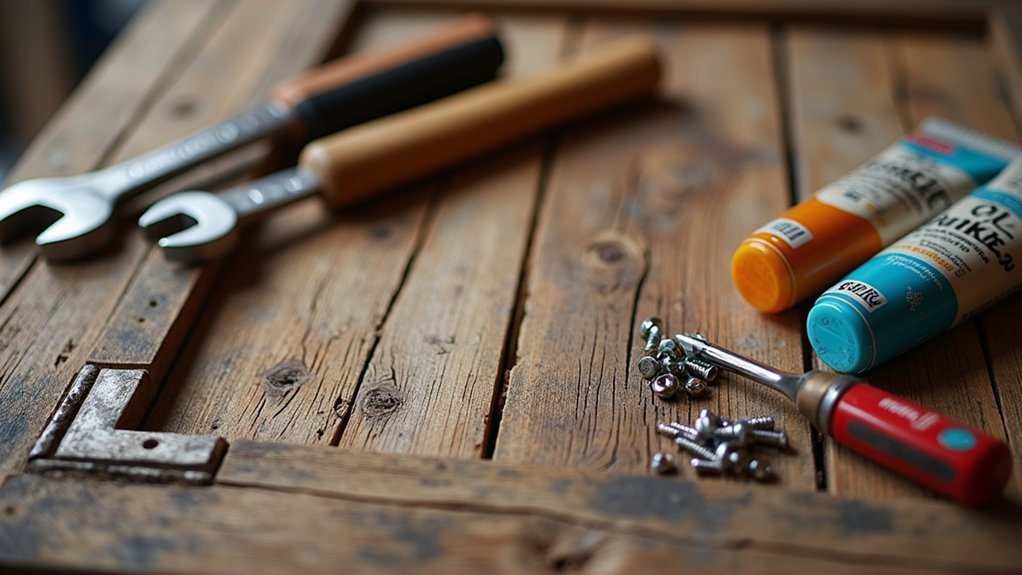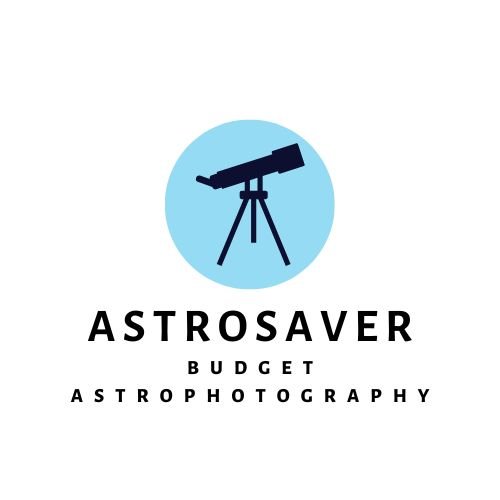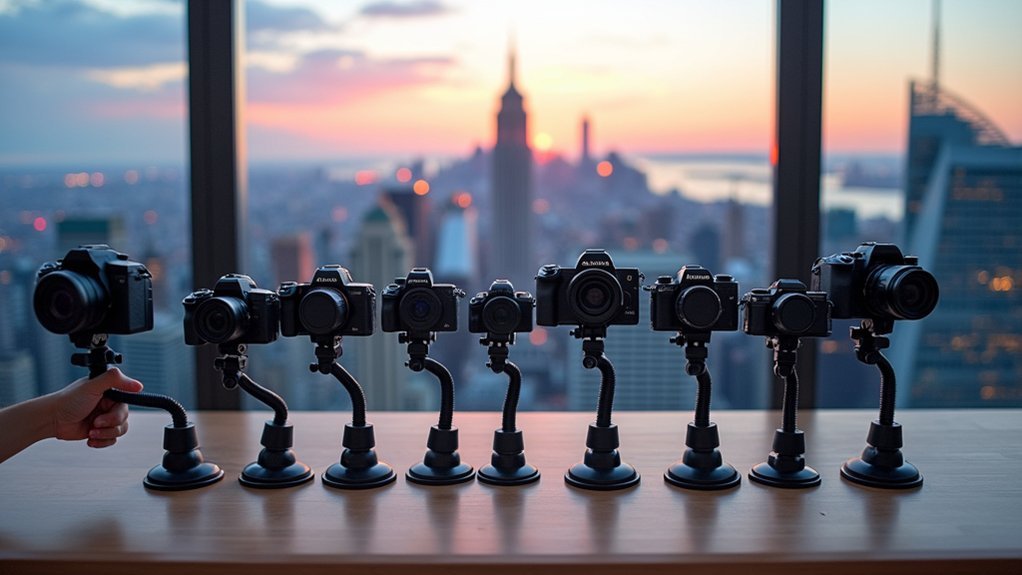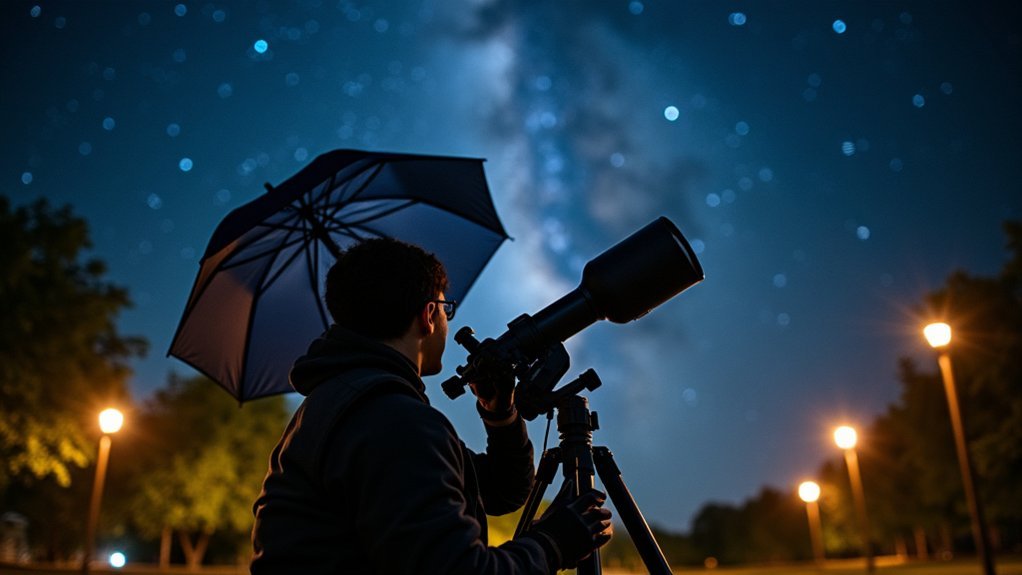A basic barn door tracker requires two 3/4-inch plywood triangular boards, a brass tubing hinge, 1/4-20 threaded rod, T-nuts, and a camera ball mount. You’ll need a drill, saw, screwdriver, and level for assembly. Optional components include a timing motor (10 RPM), portable battery, and MOSFET control circuit. Don’t forget alignment tools like a green laser or finder scope. The complete parts list below will help you create your own star-tracking platform.
Essential Wooden Components and Hardware
When building your wooden barn door tracker, you’ll need several key components to guarantee proper functionality. The essential wooden components include two triangular boards cut from cabinet-grade 3/4 inch plywood, which provide stability and support for the entire assembly.
You’ll need a brass tubing hinge to connect these boards, allowing smooth rotation as the tracker aligns with the celestial pole. A threaded rod (typically a 1/4-20 bolt) is vital for creating the controlled movement needed for tracking stars during long exposures.
Install two 1/4-20 T-nuts within the structure to secure your components and create stable mounting points for bolts.
For improved tracking precision, consider adding a Teflon piece to reduce bolt wobble, enhancing the overall smoothness of your barn door tracker’s operation.
Threaded Rod and Mounting Mechanisms
The threaded rod serves as the heart of your barn door tracker’s movement system. You’ll need a 1/4-20 bolt with 20 threads per inch, which provides the precise adjustments necessary for tracking celestial objects during long exposures.
Install a T-nut firmly into your wooden structure to secure the threaded rod and guarantee smooth rotation during operation.
When selecting your rod, consider your desired exposure duration – it must be long enough to track without binding. Mount your camera using a ball mount attached to the top board, allowing flexible positioning while maintaining stability.
Pay careful attention to aligning the threaded rod with the hinge axis, as improper alignment introduces tangent error that will blur your astrophotography. This critical adjustment guarantees your DIY tracker accurately follows the night sky’s movement.
Camera Attachment and Alignment Tools
Securing your camera properly to the barn door tracker requires several specialized components that work together to guarantee precise celestial tracking.
A precise camera setup on your barn door tracker enables accurate celestial tracking for stunning astrophotography results.
The camera ball mount attaches firmly to the top board, allowing you to position your equipment for ideal framing. For accurate alignment, you’ll need tools that verify your tracker points precisely at celestial targets.
- Install T-nuts inside the structure to provide secure anchoring for your mounting hardware.
- Attach a green laser to your camera’s hotshoe for quick alignment with Polaris or the South Celestial Pole.
- Mount a finder scope on the top board for visual confirmation of your tracking target.
- Use a tripod with adjustable hinges to properly set the tracker to your latitude for successful long exposure astrophotography.
Optional Motor and Power Supply Elements
Upgrading your barn door tracker with motorization dramatically improves tracking accuracy while eliminating the need for manual operation during long exposures.
A 10 RPM timing motor with appropriate gearing achieves the ideal constant rate of approximately 1.538 RPM needed for proper celestial tracking.
For precise control, consider a unipolar stepper motor that rotates 1.8 degrees per step (200 steps per revolution). You’ll need to drill a hole in your mount to accommodate the motor shaft.
Power options include a portable 7.2-volt NiCd battery for field use or a plug-in power supply for home setups.
A MOSFET-based control circuit enhances reliability when switching between operational modes.
Most hardware store bolts provide sufficient tracks per inch for smooth movement.
The entire setup draws only 0.189 Amps (2.27 Watts), ensuring extended run time.
Assembly Tools and Finishing Materials

Proper assembly of your barn door tracker requires six essential tools to ascertain precision and durability.
Building a precise barn door tracker demands the right tools—accuracy in assembly translates directly to stellar photography results.
You’ll need a drill to create accurate holes, a saw for cutting wood pieces to size, and a screwdriver to secure bolts and screws.
Don’t forget a level tool to confirm proper alignment for tracking celestial objects.
- Sandpaper or sanding blocks smooth rough edges after cutting, preventing splinters.
- Clamps hold pieces firmly while you’re drilling or applying wood glue.
- Wood glue strengthens joints for better stability during operation.
- Wood sealant or paint protects your finished tracker from moisture damage.
These finishing materials aren’t just cosmetic—they extend your tracker’s lifespan and improve functionality.
With these tools at hand, you’ll achieve the precision needed for effective astronomical photography.
Frequently Asked Questions
What Counterweight Materials Work Best for Heavier Camera Setups?
For heavier camera setups, you’ll want dense counterweight materials like lead weights, steel plates, or sand/shot-filled bags. They’re compact yet provide sufficient mass to balance your equipment effectively without excessive bulk.
How Do You Waterproof the Tracker for Outdoor Use?
You’ll need to apply marine-grade varnish on all wooden parts, seal electronic components with silicone conformal coating, and use waterproof covers when not in use. Consider adding rubber gaskets at connection points for extra protection.
Can This Tracker Handle Telescope Mounting?
Yes, you can mount a telescope on this tracker if it’s lightweight. Add reinforcements to the hinged platform and guarantee proper balance. Don’t exceed weight limits or you’ll compromise tracking accuracy.
What’s the Maximum Tracking Time Before Manual Readjustment?
You’ll get about 30-60 minutes of tracking time before needing to readjust. The barn door tracker’s accuracy decreases as time passes, requiring you to reset it once stars begin to trail in your images.
Will Temperature Fluctuations Affect Tracking Accuracy?
Yes, temperature fluctuations will affect your tracking accuracy as they cause wood to expand or contract. You’ll notice more drift on nights with changing temperatures, so consider using metal components for better stability.
In Summary
You’ve now got everything needed to build your own DIY wooden barn door tracker. With basic lumber, a threaded rod, and a few mounting components, you’ll capture stunning night sky photos without spending a fortune. Don’t forget to test your tracker before heading out for stargazing. Whether you go manual or motorized, you’re well-equipped to start your astrophotography journey with this simple yet effective tool.





Leave a Reply